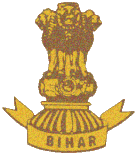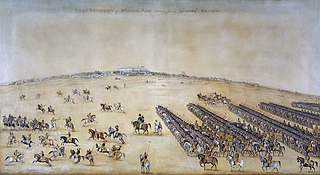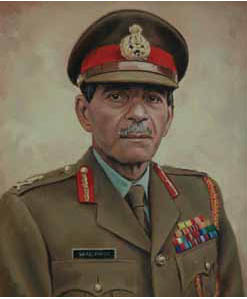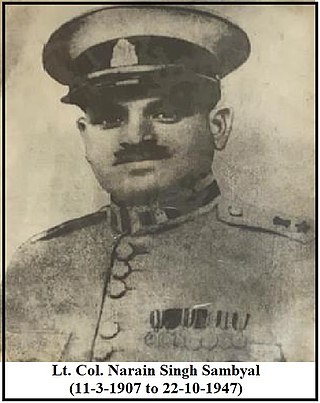
The Governor General's Bodyguard was a cavalry regiment of the British Indian Army and served as the British Indian equivalent to the Household Cavalry of the British Army.

Beating Retreat is a military ceremony dating to 17th-century England and was first used to recall nearby patrolling units to their castle.

The Mechanised Infantry Regiment is an infantry regiment of the Indian Army, comprising 27 battalions dispersed under various armoured formations throughout India. Together with the 21 battalions of Brigade of the Guards, they form part of the Mechanised Infantry arm, which along with the Armoured Corps form the Mechanised Forces.

The Sikh Regiment is an infantry regiment of the Indian Army. It is the most highly decorated regiment of the Indian Army and in 1979, the 1st battalion was the Commonwealth's most decorated battalion, with 245 pre-independence and 82 post-independence gallantry awards, when it was transformed into the 4th battalion, Mechanised Infantry Regiment. The first battalion of the regiment was officially raised just before the partial annexation of the Sikh Empire on 1 August 1846, by the British East India Company. Currently, the Sikh Regimental Centre is located in Ramgarh Cantonment, Jharkhand. The Centre was earlier located in Meerut, Uttar Pradesh.

Field Marshal Kodandera Madappa Cariappa, was an Indian military officer and diplomat who was the Indian Commander-in-Chief (C-in-C) of the Indian Army. He led Indian forces on the Western Front during the Indo-Pakistani War of 1947. He was appointed Commander-in-Chief of the Indian Army in 1949. He is one of only two Indian Army officers to hold the five-star rank of Field Marshal; the other being Field Marshal Sam Manekshaw.

The Poona Horse is an armoured regiment in the Armoured Corps of the Indian Army. The regiment, known before independence as The Poona Horse, was raised as a regular cavalry regiment in the Bombay Presidency army of the East India Company. It was formed from the 3rd Regiment of Bombay Light Cavalry, raised in 1820, and the Poona Auxiliary Horse, raised about 1817–18. The latter unit was absorbed into the regular forces about 1860 and the two regiments later became the 33rd Queen Victoria's Own Light Cavalry and the 34th Prince Albert Victor's Own Poona Horse.

The Bihar Regiment is an Indian Army infantry regiment. It traces its origins back to the British Indian Army. The Bihar Regiment was formed in 1941 by regularising the 11th (Territorial) Battalion, the 19th Hyderabad Regiment, and raising new battalions. The Bihar Regimental Centre (BRC) is located at Danapur Cantonment, Patna, the second oldest cantonment of India. INS Vikramaditya, the Indian Navy's largest ship and one of its two aircraft carriers is affiliated to the Bihar Regiment, Indian Army's highly decorated and battle-hardened unit.

The 1st Horse (Skinner's Horse) is a regiment of the Armoured Corps of the Indian Army. It traces its origins as a cavalry regiment from the times of the East India Company, followed by its service in the British Indian Army and finally, after independence as the fourth oldest and one of the senior cavalry regiments of the Armoured Corps of the Indian Army.

The Deccan Horse or 9 Horse is one of the oldest and most decorated armoured regiments of the Indian Army. The Royal Deccan Horse , which was a regular cavalry regiment of the British Indian Army was formed from the amalgamation of two regiments after World War I. They saw service from the Mutiny of 1857 up to and including World War II.

The 61st Cavalry Regiment is a horse-mounted cavalry regiment of the Indian Army. It is notable for being one of the largest, and also one of the last, operational non mechanised horse-mounted cavalry units in the world. Formerly deployed into active conflict, the 61st Cavalry is currently employed on ceremonial occasions, though it can be deployed for internal security or provide military aid to the civil power.

The Delhi Republic Day parade is the largest and most important of the parades marking the Republic Day celebrations in India. The parade takes place every year on 26 January at Kartavya Path, New Delhi. It is the main attraction of India's Republic Day celebrations, which last for three days. The first parade was held in 1950, and it has been held every year since. The cultural pageant is a symbol of a diverse but united India.
20th Lancers is an armoured regiment in the Armoured Corps of the Indian Army. The regiment distinguished itself in operations with its defence of Chhamb in Jammu and Kashmir during the 1965 Indo-Pakistan War and won one Maha Vir Chakra. It has provided one Chief of Army Staff and two Army Commanders.
66th Armoured Regiment is an armoured regiment which is part of the Armoured Corps of the Indian Army.

68th Armoured Regiment is an armoured regiment which is part of the Armoured Corps of the Indian Army.
First Lady of India or First Gentleman of India is the title given to the host of the Rashtrapati Bhavan, usually the spouse of the president of India. There are no official roles or duties assigned to the spouse. The spouse generally attends official ceremonies and functions.

Lieutenant General Walter Anthony Gustavo 'WAG' Pinto, PVSM was a General Officer in the Indian Army. He last served as the 8th General Officer Commanding-in-Chief of the Central Command. As a major general, he led the 54th Infantry Division on the western front in the Indo-Pakistani War of 1971, for which he was awarded the Param Vishisht Seva Medal.

The President's Colour Award is the highest honour that can be bestowed upon any military unit of India. It is also known as Nishaan, which is an emblem that is worn by all unit officers on the left-hand sleeve of their uniform.

71 Armoured Regiment is an armoured regiment of the Indian Army.
72 Armoured Regiment is an armoured regiment of the Indian Army. The regiment was raise at Ahmednagar, Maharashtra on 1st July 1971.

Colonel Narain Singh Sambyal, OBE, also remembered as the Savior of Kashmir, was a Commander of 4th Jammu and Kashmir State Forces who died fighting during the First Kashmir War at Domel Muzaffarabad.
























